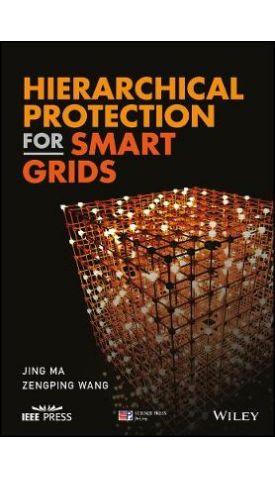אנו משתמשים ב-Cookies כדי לשפר את החוויה שלך. כדי לקיים ההנחיה החדשה של e-Privacy, עלינו לבקש את הסכמתך להגדיר את ה-Cookies. קבלת מידע נוסף.
808.00 ₪
Hierarchical Protection for Smart Grids
808.00 ₪
ISBN13
9781119304807
יצא לאור ב
New York
זמן אספקה
21 ימי עסקים
עמודים
476
פורמט
Hardback
תאריך יציאה לאור
19 ביוני 2018
שם סדרה
Wiley - IEEE
A systematic view of hierarchical protection for smart grids, with solutions to tradition protection problems and complicated operation modes of modern power systems
- Systematically investigates traditional protection problems from the bird's eye view of hierarchical protection
- Focuses on multiple variable network structures and complicated operation modes
- Offers comprehensive countermeasures on improving protection performance based on up-to-date research
| עמודים | 476 |
|---|---|
| פורמט | Hardback |
| ISBN10 | 1119304806 |
| יצא לאור ב | New York |
| תאריך יציאה לאור | 19 ביוני 2018 |
| תוכן עניינים | About the Author ix Foreword xi Preface xiii Introduction xv 1 Basic Theories of Power System Relay Protection 1 1.1 Introduction 1 1.2 Function of Relay Protection 1 1.3 Basic Requirements of Relay Protection 3 1.3.1 Reliability 3 1.3.2 Selectivity 4 1.3.3 Speed 4 1.3.4 Sensitivity 5 1.4 Basic Principles of Relay Protection 6 1.4.1 Over-Current Protection 6 1.4.2 Directional Current Protection 6 1.4.3 Distance Protection 7 1.5 Hierarchical Relay Protection 9 1.5.1 Local Area Protection 10 1.5.2 Substation Area Protection 11 1.5.3 Wide Area Protection 12 1.5.4 Constitution Mode of Hierarchical Relay Protection 13 1.6 Summary 15 References 15 2 Local Area Conventional Protection 17 2.1 Introduction 17 2.2 Transformer Protection 18 2.2.1 Adaptive Scheme of Discrimination between Internal Faults and Inrush Currents of Transformer Using Mathematical Morphology 18 2.2.2 Algorithm to Discriminate Internal Fault Current and Inrush Current Utilizing Variation Feature of Fundamental Current Amplitude 30 2.2.3 Identifying Transformer Inrush Current Based on Normalized Grille Curve (NGC) 39 2.2.4 Adaptive Method to Identify CT Saturation Using Grille Fractal 50 2.2.5 Algorithm for Discrimination Between Inrush Currents and Internal Faults Based on Equivalent Instantaneous Leakage Inductance 57 2.2.6 A Two-Terminal Network-Based Method for Discrimination between Internal Faults and Inrush Currents 70 2.3 Transmission Line Protection 82 2.3.1 Line Protection Scheme for Single-Phase-to-Ground Faults Based on Voltage Phase Comparison 83 2.3.2 Adaptive Distance Protection Scheme Based on the Voltage Drop Equation 99 2.3.3 Location Method for Inter-Line and Grounded Faults of Double-Circuit Transmission Lines Based on Distributed Parameters 117 2.3.4 Adaptive Overload Identification Method Based on Complex Phasor Plane 134 2.3.5 Novel Fault Phase Selection Scheme Utilizing Fault Phase Selection Factors 148 2.4 Summary 172 References 172 3 Local Area Protection for Renewable Energy 175 3.1 Introduction 175 3.2 Fault Transient Characteristics of Renewable Energy Sources 176 3.2.1 Mathematical Model and LVRT Characteristics of DFIG 177 3.2.2 DFIG Fault Transient Characteristics When the Crowbar Protection Is Not Put into Operation 178 3.2.3 DFIG Fault Transient Characteristics When the Crowbar Protection Is Put into Operation 211 3.3 Local Area Protection for Centralized Renewable Energy 230 3.3.1 Connection Form of a Wind Farm and its Protection Configuration 231 3.3.2 Adaptive Distance Protection Scheme for Wind Farm Collector Lines 233 3.3.3 Differential Protection Scheme for Wind Farm Outgoing Transmission Line 239 3.4 Local Area Protection for Distributed Renewable Energy 248 3.4.1 Adaptive Protection Approach for Distribution Network Containing Distributed Generation 248 3.4.2 Islanding Detection Method 255 3.5 Summary 269 References 270 4 Topology Analysis 273 4.1 Introduction 273 4.2 Topology Analysis for Inner Substation 273 4.2.1 Characteristic Analysis of the Main Electrical Connection 274 4.2.2 Topology Analysis Method Based on Main Electrical Wiring Characteristics 275 4.2.3 Scheme Verification 278 4.3 Topology Analysis for Inter-substation 284 4.3.1 Static Topology Analysis for Power Network 285 4.3.2 Topology Update for Power Network 287 4.3.3 Scheme Verification 291 4.4 False Topology Identification 294 4.4.1 Road-Loop Equation 294 4.4.2 Analysis of the Impacts of Topology Error and Undesirable Data on Branch Current 296 4.4.3 Topology Error Identification Method Based on Road-loop Equation 300 4.4.4 Scheme Verification 301 4.5 Summary 315 References 316 5 Substation Area Protection 317 5.1 Introduction 317 5.2 Substation Area Protection Based on Electrical Information 317 5.2.1 Substation Area Regionalization 318 5.2.2 Typical Fault Cases 323 5.2.3 Scheme Performance Analysis 326 5.3 Substation Area Protection Based on Operating Signals 327 5.3.1 Setting Principle of Adaptive Current Protection 327 5.3.2 Supporting Degree Calculation Method 330 5.3.3 Substation Area Current Protection Algorithm 334 5.3.4 Scheme Verification 338 5.4 Summary 346 References 346 6 Wide Area Protection 347 6.1 Introduction 347 6.2 Wide Area Protection Using Electrical Information 347 6.2.1 Wide-Area Protection Using Fault Power Source Information 348 6.2.2 Wide-Area Protection Using Fault Network Information 358 6.2.3 Wide-Area Protection Suitable for Multiple Fault Identification 369 6.3 Wide Area Protection Using Operating Signals 375 6.3.1 Wide-Area Protection Based on Distance Protection Operational Signal 376 6.3.2 Wide-Area Protection Based on Current Protection Operational Signal 393 6.3.3 Wide-Area Protection Based on Virtual Impedance of Fault Component 406 6.4 Wide Area Tripping Strategy 419 6.4.1 Tripping Strategy Based on Directional Weighting 419 6.4.2 Simulation Verification 428 6.5 Summary 432 References 433 Appendices 435 Index 439 |
| זמן אספקה | 21 ימי עסקים |



Login and Registration Form